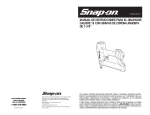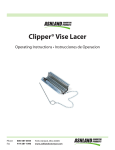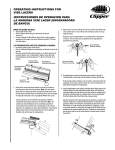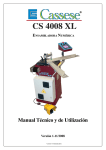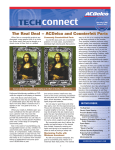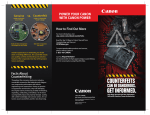Download D400 Manual de Usuario
Transcript
Important Safety Instructions Read and understand all of the instructions. Follow all warnings and instructions marked on the unit. Unplug this product from the wall outlet and refer servicing to qualified service personnel under the following conditions: ! This product should be operated only from the type of power source indicated in the user guide. If you are not sure of the type of power supply in your location, consult your dealer or local power company. Never push objects of any kind into the unit through case slots, since they may touch dangerous voltage points or shortcut parts, resulting in a risk of fire or electric shock. Do not use this product in areas where it may be exposed to water or other liquids. Unplug this product from the wall outlet before cleaning. Do not use liquid cleaners or aerosol cleaners. Use a damp cloth for cleaning. Do not operate the unit in areas with high temperature or high humidity since it may prevent it from working correctly. 2 ! ! ! ! When the power supply cord or plug is damaged or frayed. If liquid has been spilled into the unit. If the unit has been exposed to rain or water. If the product has been dropped or the case has been damaged. If the product shows a noticeable change in performance. To reduce the risk of electric shock, do not disassemble this product. Take it to qualified service personnel when service or repair work is required. Opening or removing covers may expose you to dangerous voltages or other risks. Incorrect re-assembly can cause electric shock when the unit is subsequently used. Not following these safety instruction will expose you to severe/fatal risks which since already disclosed will be the sole responsibility of the user. 1.0 Before Starting Congratulations, you have in your hands a counterfeit bill detector equipped with the most efficient detection technology. The automatic loading system, combined with an integrated audible alarm and LED warning light will make bill verification the simplest of tasks. Standard Features: Contrast detection sensors External ultraviolet (UV) detector Audible alarm Red LED warning light Automatic banknote feeding Operates on 110V We recommend the user to verify that the box contains all of the items listed here: D400 Unit User’s Guide Warranty Card 3 2.0 Counterfeit Detection Function Connect the unit to a power outlet. Proceed to turn the unit ON by pressing the ON/OFF switch located in the back of the unit (see figure 1). Open the two plastic covers that protect the automatic feeding system (see figures 2-a through 2-c). 4 Figure 1 Figure 2-a Figure 2-b Figure 2-c Set the detection mode according to the type of bills you want to analyze. The unit has two bill settings (see figure 3): Old: for bills printed before 1996 New: for bills printed after 1996 Note: this unit cannot verify: 1) $1 or $2 dollar bills, 2) dollar bills made in or before 1988. Figure 3 Since detection accuracy depends on selecting the right bill setting, we encourage you to always match your selection with the type of bill you want to analyze. Once the proper bill setting is selected, insert the bills you intend to analyze, one by one, throughout the top-loading slot (see figure 4). Follow these recommendations before inserting a bill: Insert the bills in the position and direction indicated here (see figure 5). Figure 4 Figure 5 5 Avoid inserting banknotes that are torn, too old or crumpled; avoid banknotes that have staples attached, or that have been covered totally or partially with adhesive media. Never insert wet or heavily stained bills. $ $ $ $ $ $ $ $ Once a bill has been inserted into the unit, the detection system will alert the user with an audible signal if the banknote is legitimate or suspicious. If a bill is legitimate: once the bill is analyzed, the unit will emit a single beeping sound. If a bill is suspicious: once the banknote is analyzed, the unit will emit five alternate beeping sounds. Additionally, the red LED warning light will blink. Once analyzed, all bills legitimate or dubious will be deposited on the stacker (see figure 6). Figure 6 6 3.0 Ultraviolet Detection Function Place the bill you want to analyze in the slot located in the front of the unit (see figure 7). Visually, verify that the UV features printed and embedded in the analyzed bill fluoresce under the UV light. NOTE: For written warranties, refer to the Warranty Card included in the box. Figure 7 Note: The D-400 is a useful instrument to verify the legitimacy of bills. However, the D400, like any other detector in the market, cannot guarantee the legitimacy of any bill analyzed by it due to the unpredictable techniques or advances that counterfeiters may introduce. 7 4.0 Specifications Weight: Dimensions: Currency Accepted: Detection Devices: Power Consumption: Power Supply: 8 2.0 kg (4.5 lb) 8 ¼” x 8 ¼” x 4 ½” (210mm x 210mm x 11.5mm) All denominations of U.S. Dollar (except $1 and $2 dollar bills) Contrast detection sensors and external UV Fluorescence 6 Watts 110V Instrucciones de Seguridad Lea y entienda todas las instrucciones. Siga todas las precauciones e instrucciones señaladas en la unidad. Este producto deberá ser operado utilizando el voltaje correcto indicado en la guía de usuario. Si no está seguro del tipo de voltaje, consulte al distribuidor o a su compañía proveedora de electricidad. Nunca inserte objetos de ningún tipo por las rejillas o aberturas de la unidad ya que podrían tocar partes energizadas, resultando en descarga eléctrica, fuego o daño a la unidad. Desenchufe la unidad de la toma de alimentación y llévela a un centro autorizado de servicio en los siguientes casos: ! Cuando el cable eléctrico esté dañado o gastado. ! Si algún líquido ha sido derramado sobre la unidad. ! Si el producto ha sido expuesto al agua u otros líquidos. ! Si el producto muestra algún cambio notorio en su funcionamiento. No opere este producto en lugares donde pueda estar expuesto al agua o cualquier otro líquido. Antes de comenzar a limpiar la unidad, desenchúfela de la toma de alimentación eléctrica. No utilice limpiadores líquidos o en aerosol. Use únicamente un paño humedecido en agua. Para reducir el riesgo de descarga eléctrica, no desmantele la unidad. Cuando sea necesaria una reparación, llévela a un centro autorizado de servicio. Abrir o quitar la cubierta puede exponerlo a altos voltajes u otros riesgos. El ensamblaje incorrecto puede causar una descarga eléctrica cuando se vuelva a utilizar la unidad. No opere esta unidad en áreas con altas temperaturas o excesiva humedad ya que puede resultar en un mal funcionamiento de la misma. No utilice esta unidad si el cable eléctrico está dañado o el contacto en la clavija está suelto. No seguir estas instrucciones puede resultar en descarga eléctrica, fuego u otros peligros. Cuando no use la unidad por un tiempo prolongado, desenchufe la clavija de la toma de alimentación. No seguir estas instrucciones de seguridad supone los riesgos que en ellas se advierten y exonera al fabricante/distribuidor de las responsabilidades por daños que esta conducta pudiera ocasionar. 9 1.0 Antes de Empezar Felicitaciones, usted tiene en sus manos un detector de billetes falsificados equipado con la más eficiente tecnología de detección. Su sistema de alimentación automático y alarmas audible y visual harán que verificar billetes sea una de las tareas más sencillas en su entorno. Características Estándar: Sensores de detección por contraste Detector ultravioleta (UV) externo Alarma audible Señal luminosa de alerta (LED rojo) Sistema de alimentación automático Funcionamiento a 110V Recomendamos al usuario que verifique que todos los artículos listados a continuación se encuentren en la caja: Unidad D-400 Manual de Usuario Tarjeta de Garantía 10 2.0 Función de Detección de Billetes Falsos Conecte la unidad a una toma de corriente. Ponga en funcionamiento la unidad presionando el botón ON/OFF que se encuentra en la parte posterior (ver figura 1). Abra las dos cubiertas plásticas que protegen el sistema de alimentación (ver figuras 2-a, b y c). Figura 1 Figura 2-a Figura 2-b Figura 2-c 11 Seleccione el tipo de billetes que desee analizar. La unidad tiene dos modos de detección de acuerdo al tipo de billetes (ver figura 3): “Old” (billetes antiguos): para billetes impresos antes de 1996 “New” (billetes nuevos): para billetes impresos después de 1996 Nota: esta unidad no puede verificar: 1) billetes de $1 o $2 dólares, 2) billetes hechos en o antes de 1988. Figura 3 Ya que la precisión del detector depende de la correcta selección del tipo de billete, recomendamos que siempre verifique que el tipo de billete a analizar corresponda con el modo seleccionado. Una vez seleccionado el tipo de billete, inserte los billetes que desee analizar, uno por uno, a través de la abertura ubicada en la parte superior (ver figura 4). Siga estas recomendaciones antes de insertar un billete: Inserte los billetes en la posición y dirección indicadas aquí (ver figura 5). 12 Figura 4 Figura 5 Evite insertar billetes que estén rotos, demasiado viejos o arrugados. Evite insertar billetes que hayan sido engrapados o que estén cubiertos total o parcialmente con cinta adhesiva. Nunca inserte billetes húmedos o profusamente manchados. $ $ $ $ $ $ $ $ Una vez que el billete haya sido insertado, el usuario será alertado mediante señales audibles si es que el billete es legítimo o sospechoso. Si el billete es LEGÍTIMO: cuando es insertado en la unidad, esta emitirá una señal audible. Si el billete es SOSPECHOSO: cuando es insertado en la unidad, esta emitirá cinco señales audibles. Además, la señal luminosa de alerta (LED rojo) parpadeará. Una vez analizados, todos los billetes legítimos o sospechosos, serán depositados en la bandeja receptora (ver figura 6). Figura 6 13 3.0 Función de Detección Ultravioleta Coloque el billete que desee analizar en la abertura frontal (ver figura 7). Verifique visualmente que las marcas "UV" presentes en el billete muestren fluorescencia bajo el efecto de la luz ultravioleta. NOTA: Las garantías escritas de este producto se encuentran en la Tarjeta de Garantía incluida con la unidad. Figura 7 Nota: El detector D-400 es una herramienta útil para verificar la legitimidad de billetes. Sin embargo, al igual que cualquier otro detector en el mercado, el D-400 no garantiza la legitimidad de los billetes analizados debido a los avances impredecibles en falsificación de dinero. 14 4.0 Especificaciones Peso: Dimensiones: Moneda aceptada: Sistema de Detección: Consumo de Electricidad: Fuente de Alimentación: 4.5 lb (2.0 kg) 8 ¼” x 8 ¼” x 4 ½” (210mm x 210mm x 11.5mm) Todas las denominaciones de dólar (excepto billetes de $1 y $2) Sensores de contraste y fluorescencia UV externa 6 Watts 110V 15
















